There are few certainties in life, but if you have a TikTok account, you’d have come across Crystal Dolphin. When producer, Engelwood, released the song in 2017, it went under the radar as a slight shift from his usual sound. Then the magic of the internet took over. One dancing meme turned into two, and before long, it was featured in millions of videos. I tried working my way through a few before writing this article and found myself falling down a wormhole of out-of-control teenagers, athletic feats and “aw that’s cute” featuring just about every animal in the kingdom.
I may be too old for TikTok, but I like to think I’ll never be too old for positive vibes and a great piece of art, especially when it involves a healthy dose of ‘80s and ‘90s nostalgia. Step up Indonesian motion design Ardhira Putra.
Brought together by a shared love for Japanese culture, animation, and Asian influences, Ardhira seemed like just the man to create the official music video in keeping with Engelwood’s vision. Of course, there’s a whole lot of pressure that comes with making a video for a track that already had over 100,000,000 streams (I almost lost count of the zeros).
We sat down with both Engelwood and Ardhira to discuss their influences in art and music, why the video took five months to make and what other creatives can do to bridge the gap between music and design.
Okay, let’s start with the music. Engelwood, could you give us a brief introduction to yourself?
Engelwood:
Sure. I’m 25 years old. I’m from New Jersey, born in Illinois.
I didn’t really start producing until I was 18. I was a junior in high school, but I got suspended and just started making music. And then, yeah, it kind of just went from there.
I went to the University of Wisconsin, Madison, and by about halfway through, I was working on music enough for it to be full time, and then after I graduated, that’s when I started focusing on it.
I was DJing on tour with the rapper Yung Gravy, and during that time, that’s when the Crystal Dolphin stuff blew up. At that point, I stopped being a DJ and decided to focus more on my own career path. And that’s where we are now, just kind of working on music. I’ve just put my Yacht World album out two or three months ago.
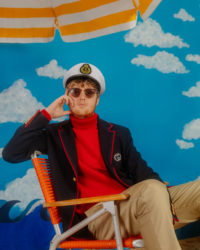
Engelwood
When you made the track, was it tough to put together, and did you think it would be so successful? It’s been a couple of years since it was released now, right?
Engelwood:
Yeah. It’s been a while. The song really did not take me that much time to make. It was something I threw together very quickly, really late at night, and I was just kind of goofing around. I wasn’t even going to put it on that album initially because I wasn’t really making music for people to dance to back then, so I wasn’t sure if my fans were going to like it.
But, I found myself listening to it over and over again. I was like, well, if I keep listening to the song, other people are probably gonna like it too. So, I said screw it, and I put it out, but it didn’t really blow up for a while. In fact, it was on what was probably one of my least popular albums for a long time. And then, yeah, all it took was one person on TikTok to do some dance, and then it just went from there.

Crystal Dolphin did seem like an outlier at the time. Did the kind of success you had with that track influence the sound you developed for Yacht World?
Engelwood:
Yeah, for sure. I felt like I was kinda getting burnt out on the whole chill playlist stuff. Also, whenever I’d play shows and stuff, I wouldn’t really have too many songs that would get people super hype. It feels kind of awkward when you’re DJ’ing to a bunch of people who are just kind of like nodding their heads [laughs]. I felt like I had to progress too, I don’t like doing the same thing every time. I figured taking it towards a more dancy house, funk direction felt natural. I love that stuff in music too.
What other influences have you had on your work?
Engelwood:
The two biggest inspirations are probably Madlib and Flamingosis. I heard Flamingosis when I was a freshman in college, and it just blew my mind how good it was, how he used samples and all that stuff. He was a huge influence on me. He’s also from New Jersey, and we had really similar styles. I took his influence and kind of twisted towards this beach theme, I guess. But I’m inspired by so much stuff, like Bossa Nova, for example; I’d say Brazilian and Japanese music are probably my favorites. They put such an interesting twist on funk and a lot of the genres popular in America. I’m exploring all different types of music. I’m currently listening to a lot of from Thailand as well. I find it really interesting to hear different countries take on funk and soul.
Also, I almost forgot, Daft Punk was a huge influence on me, obviously. They kind of introduced me to sampling disco tracks and stuff too, because I didn’t even put together that their tracks were sampled until I saw a video of some guy recreating them, and I was like, wow, this is, so, so cool. So yeah, that got me into funk music, and I realized I wanted to make something that people can still chill out to, still have the beach vibe, but can also move and groove to.

This is a good time to bring you in, Ardhira. Can you give us a little introduction to your creative background. What led you to be a motion designer?
Ardhira:
I was born in 1988. I’m an Indonesian currently working in Singapore.
I’ve been interested in graphic design since I was 16. I used to love going to the bookstore in Indonesia. I found a magazine called International Design Network Magazine; it was famous to graphic designers back then. I was in high school, and at the time, I was only using my graphic design skills to edit my profile picture in the Friendster [laughs].
I would also go to the cinema a lot as well. I really liked watching anything from Michel Gondry, who made Daft Punk Around the World. Then I decided to study animation at the Multimedia University in Malaysia. My college community led me to believe that you had to join a big company if you wanted to live as an animator. So, my mindset back then was like, well, I want to work for Pixar or a big motion studio with a desk in New York, like Buck.
But I’m always thinking, what is my target? Why am I doing this? I mean, when I was a kid, I really liked playing video games and all the Japanese influences. I realized I didn’t want to work in the industry; I wanted to create what really matters to me. That’s why I started to work on my personal projects from around 2017 and then got involved with independent musicians.

Ardhira Putra
Well, let’s talk more about that. Engelwood, you’re a Brooklyn-based producer. Ardhira, you’re a Singapore-based motion designer. How did you guys find each other? How did this come together?
Engelwood:
My manager, Eric, connected me at first, actually. He knew about Ardhira and showed me his Instagram, and I was like, “how the hell have I never seen this stuff before? Obviously, I want to work with him.” It was kind of; it was just instant.
Ardhira:
Yeah, I think Eric phoned me about the Macross 82-99 video I created last year.
Engelwood:
I’m also inspired by a lot of Japanese artists, and I saw that influence in Ardhira’s work, and it was just so bright and colorful, which is what I love. It felt like it was a perfect match in that I could picture the video right away.
Ardhira, the video has a multitude of influences. Could you tell us more about this?
Ardhira:
Yeah. As I said, I started putting a collection of my personal projects on Instagram in 2017. I knew I wanted to create Vintage Asian Pop Graphics, but at the time, there wasn’t really anything out there fitting with my vision, so I just kept practicing.
Years later, when the collaboration with Engelwood and Crystal Dolphin came along, I already had a clear vision for the concept in my mind. From there, I created a world – a universe – with all the visuals. I wanted the animation and illustration to have a theme: summer, with eighties or nineties and also all the Japanese influences.
In the animation visualizer for the five tracks before the Crystal Dolphin, I had to connect with the American culture. I really wanted to create this something using all the things I’d imagined since 2017. You can see that there are so many elements and references that go into it. It’s like all of my preferences were put into the animation.
[sp_wpcarousel id=”71511″]
Didn’t it take five months to finish? What sort of processes did you use?
Ardhira:
Yeah, it was really a long time because I have a full-time job, Monday to Friday. So I could only work on it early in the morning before work, after work, or on the weekend.
Also, Crystal Dolphin was famous before I got to it. There was an unofficial music video that had, like, 44 million views. The animation director was Masaaki Yuasa, someone I adore; he’s my idol, actually. So, when Engelwood phoned me about this project, I already had this huge amount of pressure. I was like, “oh my god, I have to create something to follow that.”
I also really like Kingo Hamada, where Engelwood took the sample from, so I was listening to it every day; I don’t know, like, a million times. On the way to work, at home, EVERYWHERE. My goal was to show the connection between Kingo Hamada and Engelwood. I wanted the story to be one of music being passed on from older to younger generations, and that music never dies; it just transitions to the next generation. Maybe in 15 years, there will be another Engelwood, but at the moment, he’s passing on Kingo Hamada to a new audience.
The production itself was pretty regular for me. I told Engelwood what I wanted to do, and he was like, “okay.” Then I started to create a storyboard and then moved to the animatics and style frames. When I have new materials, I would always send them over to him. Then I used Adobe Illustrator for creating all the assets and then Cinema 4D, and I combined it in After Effects.
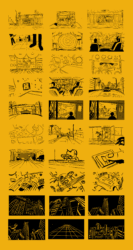
“But I’m always thinking, what is my target? Why am I doing this? I mean, when I was a kid, I really liked playing video games and all the Japanese influences. I realized I didn’t want to work in the industry; I wanted to create what really matters to me. That’s why I started to work on my personal projects from around 2017 and then got involved with independent musicians.” Ardhira Putra
What was your favorite part of the video?
Engelwood:
I have a few favorite moments for sure. I really like when the music kind of breaks off and goes into the filtered part and the guy’s driving a bike over the beach with the city in the background; that was just such a perfect shot for me.
And I love in the second drop, where it’s repeating, then all the lights are coming down, and it shows the people from the band. Once I saw that I was like, “this is incredible.” Those are my favorite moments for sure. But the whole thing is just, it’s amazing.
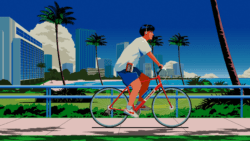
What about the most difficult?
Ardhira:
The song starts, and it’s already up-tempo. But then suddenly it drops, before slowly making its way back up. So, I’d be working on the middle part and want to show something really fast, but then suddenly, it slows down. It was difficult. Also, I think it took me five days to figure out the best way to connect the transition from the morning to the night. I’d finish my daily mission and then be like, “argh, it still not fitting.” You’ll see in the video I used the wave of the sea, but that was the last piece of the puzzle.
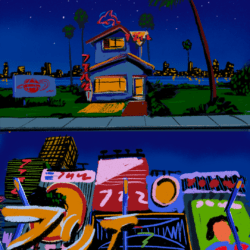
“Crystal Dolphin was famous before I got to it. There was an unofficial music video that had, like, 44 million views. The animation director was Masaki Yuasa, someone I adore; he’s my idol, actually. So, when Engelwood phoned me about this project, I already had this huge amount of pressure. I was like, “oh my god, I have to create something to follow that.” Ardhira Putra
How do you find inspiration in those difficult moments?
Ardhira:
Well, my theme for the video was summer and the city, so I watched lots of movies with a summer theme and animations with a similar vibe. I saw the ocean view, and I thought that was really good, so I tried to draw it first, then I put it in the animatic and started adding the color.
As we’re talking about inspiration, what are some of your influences, Ardhira?
Ardhira:
For the graphic influence, I have a lot of them, and most come from vintage Asian pop cultures like magazines, advertisements, commercials, vintage video games like the Sega Saturn and Nintendo 64, and also Japanese Anime from the ‘80s and ‘90s. Also, artists like Nelson Kenton, Hiroshi Nagai, Eizin Suzuki, and David Hockney inspire me a lot.

How do animators get to work with more musicians and creatives like Engelwood? What advice would you give to others?
Engelwood:
I follow a ton of animators, motion graphic designers, all of that stuff. If you’re an artist and follow the right people, you’ll get more suggestions, and then the algorithms will cater to your tastes. That’s how I found a lot of my art. I’ll just be on Instagram, scrolling through exploring or whatever. Then I’ll see someone making something I like, and I’ll just message them.
I’ve also had people reach out to me for animation work. They’ll message me and be, “Hey, I like your music. I think I could make some animation that fits your style.” Stuff like that. Just reaching out to people is probably the easiest way to do it and follow the animation scene and the people around it because it’s really cool to see. My Twitter and Instagram look so cool now because I follow all this stuff.
Ardhira:
When I was in high school and college, I loved music, and when I lived in that environment, I think I grew the muscle. It started from there, really.
I created a music video for an independent band from Jakarta, he was a friend of mine, so I decided to animate a motion sequence for him. I think from there, it began a snowball effect to other projects. And it connected me to the other musicians as well, like from Barefood, I got a MACROSS 82-99, and then I got Engelwood.
MACROSS 82-99 is a good example. I created tribute artwork for him. He then looked at my Instagram and commented that he liked it. A little while later, he said he wants to pay for me to do the lyric music video. It just shows, social media can be a really helpful tool to connect with each other.

“Working with MACROSS 82-99 is a good example. I created a free book of artwork for him. He then looked at my Instagram and commented that he liked it. A little while later, he said he wants to pay for me to do the lyric music video. It just shows, social media can be a really helpful tool to connect with each other.” Ardhira Putra
Do you have any projects in the works, individually or together?
Engelwood:
I think Yacht World’s pretty much run its course with everything. I’ll be done with all that; Crystal Dolphin was kind of the last piece. I’m working on my new album now, and I’m probably over halfway through, actually. It’s going to be a similar kind of feel, but I’m kind of going for an Italian disco sort of vibe this time.
I’m definitely going to be hitting up Ardhira for animation, so there’s going to be more collaborations for sure.
Ardhira:
For me, I think long animation projects will no longer be my focus. I am still doing looping animations for a visualizer or one that has a short production timeline. I think there might be an exciting collaboration with Engelwood in the future as well. We’ll see.
This year, I want to focus on creating my own merchandise: shirts, posters, and illustrations.

What about any longer-term goals or aspirations as artists? How would you like to see your craft and career evolve from here?
Engelwood:
I kind of feel like I’ve found what my place is. I just want to continue doing what I’m doing. I’d like to take more time to finish an album, though; I usually put one out every six months or something. That’s what it’s been like until Yacht World, anyway, which took a little bit longer. I’m trying to appease my fans into waiting a bit longer for stuff, so I can really flesh out my ideas. But yeah, I just want to do what I’m already doing.
Ardhira:
Financially, I’d like to support myself without a full-time job. I really want to survive by doing my own stuff. Maybe there will be more collaborations with musicians, or perhaps it’ll be the merchandise.
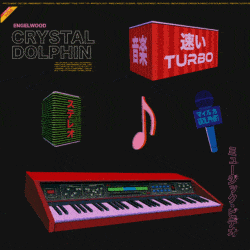
“I wanted the story to be one of music being passed on from older to younger generations, and that music never dies; it just transitions to the next generation. Maybe in 15 years, there will be another Engelwood, but at the moment, he’s passing on Kingo Hamada to a new audience.” Ardhira Putra
We’d like to thank both Engelwood and Ardhira for spending time with us and congratulate them both on such a successful collaboration.
Be sure to go and watch the video and let us know what you think in the comments. If you need me, I’ll be over on TikTok trying to work out how to suck the air out of a bin bag with a vacuum cleaner (while I’m sitting in it).
Don’t ask.
[sp_wpcarousel id=”71508″]










